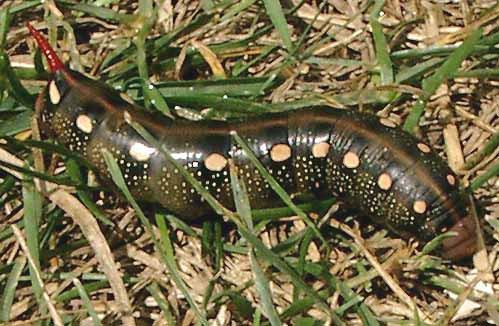Sphinginae subfamily
Sphingini tribe:
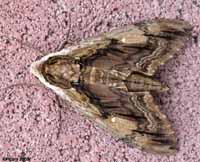 |
Ceratomia amyntor WO,
the Elm Sphinx or Four-horned Sphinx
This moth is not officially recorded in Orleans, but it
has been taken in northeastern New York and in eastern
Maine.
Larvae feed on Elm (Ulmus), birch (Betula), basswood (Tilia), and cherry (Prunus).
|
 |
This moth is recorded in Orleans, and it is probably common. It is named for the wavy lines on the forewings.
|
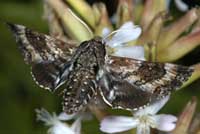 |
This moth is not recorded in Orleans County, but it has been
encountered in western N. H. and throughout most of Maine.
Larve are not limited to pawpaw.
|
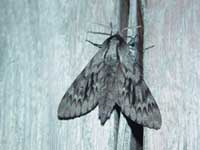 |
This moth is not reported from Orleans, but it has been seen in
nearby vermont counties and along the coast in New Hamshire and
Vermont. This is another one we have on P.E.I.
|
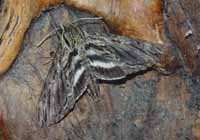 |
Lintneria eremitus
WO,
the Hermit Sphinx:
The upperside of the forewing is gray-brown with wavy lines, black
dashes, and one or two small white spots near the center of the
costa. The upperside of the hindwing is black with two white bands
and a triangular black patch at the base.
Note the golden hair on the thorax.
|
 |
This species is not recorded in Orleans, but it may be present,
although Orleans County would be
north of its eastern distribution.
|
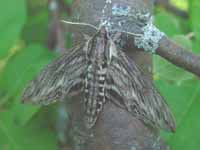
|
Sphinx canadensis
WO,
Sphinx canadensis, the Canadian Sphinx, is not common, and is not
often reported anywhere,
but it may be in Orleans County.
Larval hosts are white ash (Fraxinus americana) and blueberry
(Vaccinium).
|
 |
Sphinx chersis WO, the Northern Ash Sphinx or Great Ash Sphinx
This species is not recorded in Orleans County, but may be
present.
Larval hosts are ash, lilac, privet, cherry, and quaking aspen.
|
 |
This species is not recorded for Orleans, but it has been taken in
northern N.H. and northwestern Vermont. It is likely present.
|
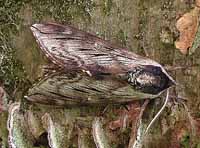 |
This species is probably present in Orleans County.
Colouration and markings are highly variable from one specimen to
another. The fringes on forewing are mostly
black with some white; those on the hindwing are mostly white with a
few black patches.
|
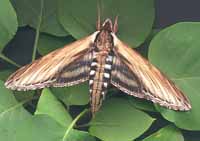 |
This species is not reported in Orleans, but I feel it may be present.
At rest the hindwings are usually completely covered.
|
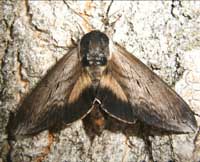 |
Sphinx luscitiosa
WO,
the Canadian Sphinx or
Clemen's Sphinx
This one is not reported from Orleans County, but it
can be fairly common in New Hampshire and Maine. It may be present. |
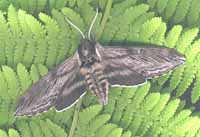 |
If you have blueberries in the woods, then you probably have the
Poecila Sphinx.
They are pretty common here on Prince Edward Island in eastern Canada.
They are reported in northeastern New York.
|
Smerinthini Tribe:
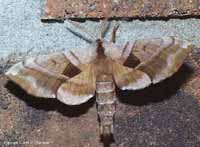 |
This moth is also fairly widely reported to the north, south and west
of Orleans.
This is the first Sphinx species I reared as a boy in New Jersey.
See the file for the female; she is different. |
 |
Pachysphinx modesta WO, the Modest Sphinx or Poplar Sphinx
This moth is found to the north, west and south of Orleans so it is
probably present there too.
They are common on Prince Edward Island. |
 |
Named for the dull grey-blue spot in the hindwing, this moth has a
wide distribution and is probably common in Orleans although not
officially recorded.
I regularly see them on Prince Edward Island, and they are reported as far south as Florida. |
 |
Paonias myops WO/JH, the Small-eyed Sphinx
Named for the small eye-spot in the hindwing, this moth has a
wide distribution
and is probably common in Orleans although not reported. Now confirmed by Jane Housewright.
I regularly see them on Prince Edward Island, and they are reported as far south as Florida.
|
Paonias myops, July 10, 2009, courtesy of Jane Housewright.
 |
Reported in northern N.H. and northeastern N.Y., this moth is probably
present in Orleans.
At my home in Montague, P.E.I., Canada, they are quite common. |
 |
This moth is widely distributed and fairly common so I suspect it is
in Orleans.
Along the East Coast, it flies from P.E.I. to Florida. |
Macroglossinae subfamily
Dilophonotini tribe:
See Hemaris comparison to help
distinguish the next three species.
 |
Hemaris diffinis WO, the Snowberry Clearwing or Bumblebee Moth
This moth is widely distributed and often reported northeast and
south of Orleans.
|
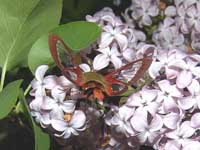 |
Hemaris gracilis
WO, the
Slender Clearwing or Graceful Clearwing
Hemaris gracilis is distinguished from similar species by a pair of
red-brown bands on the undersides of the thorax, which varies from
green to yellow-green dorsally and sometimes brown with white
underneath. They have a red abdomen.
|
 |
Hemaris thysbe WO, the Hummingbird Clearwing
This interesting day flier is not confirmed for Orleans, but
they are widely distributed in the east from P.E.I. to Florida.
|
Philampelini tribe:
 |
This moth is not reported for Orleans,
but it is fairly often reported
along the coast from southern New Jersey
to central Maine and has been seen in northern Vermont. unlikely
|
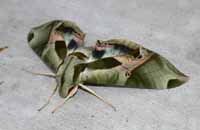 |
If you have Grape or Virginia Creeper nearby, then you probably have
this species.
I often get asked to identify larvae from areas where they have not
previously been reported.
|
Macroglossini tribe:
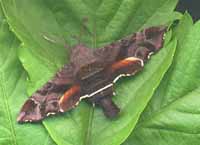 |
This day flier is widely distributed. If you have Virginia Creeper,
you probably have the Nessus Sphinx.
Two bright, distinct,
narrow yellow bands are often visible on the abdomen.
|
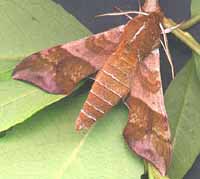 |
They are common in New Jersey and common
here on Prince Edward Island.
You will often see this species listed as Darapsa pholus,
especially in older literature. I suspect they are present.
|
 |
Darapsa myron WO, the Virginia Creeper Sphinx or the Grapevine Sphinx
This moth is not recorded on the U.S.G.S. site for Orleans County.
It is widely reported as far north as southern Maine. If you have the
foodplants indicated in the common names, you probably have this species nearby.
|
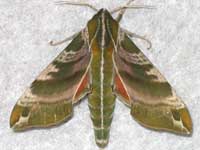 |
Darapsa versicolor
WO,
the Hydrangea Sphinx:
Fw upperside is often greenish brown with
curved dark lines and pinkish-white patches.
Hw upperside is pale yellow to reddish brown with white
along the costal margin, greenish brown along the outer margin, and
white shaded with greenish brown on inner margin.
|
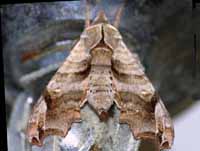 |
The moth's outer margin of the forewing is deeply scalloped.
The upperside is light brown with dark brown markings.
There is a small black and white spot near the tip.
The upperside of the hindwing is orange-brown with a dark brown outer margin and median line.
|
 |
Hyles gallii AMK, the Bedstraw Hawk Moth
or Gallium Sphinx
This species is reported in Orleans by Aaron M. Kromash.
Some years I see them on P.E.I., some years, I do not.
|
 |
Hyles lineata WO, the White-lined Sphinx
This species is not reported from Orleans County.
It is a strong migrator from the south,
and has been seen in northern New Hampshire.
|
 |
This species is not officially reported from Orleans County.
Adults fly as a single brood from April-June in meadows in coniferous
forests. Adults fly during the afternoon.
|
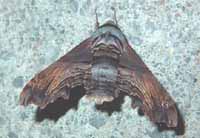 |
This moth is very much under reported. It is a
rapid day flier so is probably not in too many collections.
Grape is a popular larval host.
|
|
|
